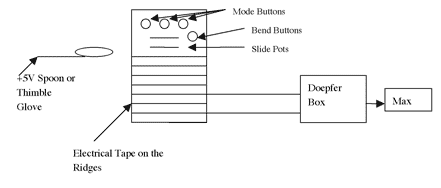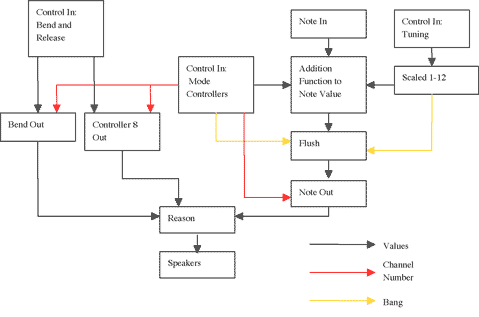
Project Report: Todd Ryan 5-14-04
The Fanciest Washboard Cletus has Ever Seen
With little knowledge of where this final project was going to end, Ahmad and I started with a simple idea of an ‘arpeggiator’ and ended up with the most revolutionary thing to hit the South since the six-shooter. This Midi-Washboard is extremely exciting because it is a new instrument; and requires new techniques and methods for playing unique from any other that I have played. Although we could spend years perfecting its playability and timbre controls, I feel that we have created an excellent prototype that inventive as well as fun to play.
Goals:
The initial goals for this project were not clear or well defined. Ahmad and I struggled to come any form of a concrete idea. I feel that this is because of a light difference in our thought process; Ahmad is a much better abstract thinker and has great ideas for pushing our project to the limits. Where as I am better versed in making of musical instrument and other prototypes; therefore I understand how it is important to set obtainable goals, reach them, re-evaluate, and create new goals. So initial brain-storming was frustrating, but we agreed that we’d create an arpeggiator with a number of timbrel controllers with the goal of creating an instrument that you could play any piece of music on. We did not want to be limited to playing the same patch or the same sample. Our primary goal was to create a simple, easy to play, fun instrument with an emphasis on arpeggios.
How the Instrument Works:
All the data is created by three sources: a five volt spoon or thimble fingered glove completing a circuit, 14 buttons, and two slide potentiometers. The spoon and ridge combination makes notes; the mode buttons change which note each ridge plays; the bend buttons bend the note(s) up or down a half step; one slide pot changes the tuning and one slide pot changes the release. All these in combination should allow the player to hit every note in the scale, have complete artistic control, and to create some diverse and interesting sounds. The physical set up can be seen in Figure 1.
Figure 1: Washboard Setup

All this variation in sound is achieved through data manipulation in Max. The note in values are changed depending on which mode one selects, what value the tuning slide pot is on, and the value of the bend controller. The bend and release controllers need very little manipulation but rather use max to get directed to the correct channel and therefore Subtractor module in Reason. The max patch we created is basically represented in Figure 2 using black arrows for values, red arrows for channel numbers, and yellow arrows for bangs.
Figure 2: Representation of Max Patcher

Unfortunately, I cannot describe in detail what parameters Ahmad changed in each subtractor module. However, he did a great job matching the emotion of a mode to the tambre of the module. The only parameters I programmed were the pitch-bend and release. The pitch bend requires no programming once the channel number is banged accordingly. The release required me to assign controller eight and the respective channel to each release slider of the amplitude filter of each Subtractor. This is not difficult, but rather just grunt work considering we had a number of Subtractor modules.
Gesture Controllers:
Ahmad and I used only two types of sensor or controllers: buttons and slide potentiometers. And unfortunately only the strips on the board in combination with the +5V glove could be considered a gesture controller (I group the tape/glove in with the button because it is theoretically similar).
Gesture controllers were not high on our list of goals and priorities. But we did consider adding some towards the end of our project. The problem was that we used all 16 slots in the controller part of the doepfer box; there isn’t room for any more controllers! If I were to do this project again I would suggest inputting the 12 button as note values rather than controllers. Inputting it as a note or a controller is virtually equivalent and would require no more programming with one way or the other. We didn’t make the switch because our max patch is so involved that it would have been difficult at that time.
If I could add a gesture controller I think I would add something that would involve the head and would be easy to control and have subtle affect on the timbre of the instrument.
Chronology:
Even with construction started, Ahmad and I were not on the same page. However when I showed him the first step towards the washboard, he saw exactly what I saw: the potential to create an awesome instrument. The first step I took was to lay down all the insulating and electrical tape on the washboards face. Once we had that down we could start the programming of the max patch.
The max patch started off really rough. I created the first ones that used the incoming note to send a bang to a make-note function. However, we both agreed that we’d rather have total control of the note. Ahmad then took the lead making a patch that we called pure-note (as opposed to a ‘make-note’) that is the basis for the one we use today. I spent much of this time attaching all 18 note wires together in a big umbilical cord in order to cut down interference and make the instrument neater.
Ahmad and I continued to add our own touches to the patchs (in Max and Reason) and to the washboard. I added 14 buttons to the top of the washboard which allow the player to choose between 12 different musical modes and to bend the pitch up or down a half step. Ahmad did the programming of adding the 12 different modes and making it possible to output them all on different channels. I also added two slide potentiometers and did the programming for those guys so that one controls the release of the note and one controls the overall tuning. Ahmad created the different Subtractors for each channel and I made the glove.
We both put in a lot of time and effort and did well dividing up the responsibilities. We did this so well, that we hardly worked in the lab at the same time. I’d go in and when I was done, I’d call him to let him know the progress and we’d discuss where to go from there. Ahmad would do the same for me, and pretty soon we had finished the goals we had originally made and exceeding them.
The only way that we changed our goals throughout this entire process was to heighten them.
Problems:
This project was far less riddled with errors, roadblocks, and confused students. One of the only problems that I had was in creating the bend up and bend down. It took a while to get each to send out a bang at the right time and to send out a value of 64 every other time. But just a little more time spent trying things in max, and I solved it.
In the same day, I had trouble making sure that the bend went to the right subtractor. However Ahmad’s part of the patch had a channel number being banged each time you changed the mode, so I stole that number and also had it bang to the bend-in function. Therefore the bend would only affect the subtractor you had selected.
This problem, like the last, was solved in a matter of minute rather than a matter of days. This was the difference from the last project. We now know the whole Midi set-up so much better; and we know Reason and Max so much better that we were able to achieve our goals much quicker than in the last project.
Conclusions and Recommendations:
I have to say that I am horribly proud of what Ahmad and I have created and the manner in which we created it. Everything from conception to implementation went smoothly; we handled it professionally and worked well as a team despite our difference in approach and style.
Having said that, given time and resources, there are a couple of things that I would do differently. First, I felt like the ridges were too close or that the thimbles were too large. Instead of putting thimbles, I would use conductive tape, tinfoil or other conductive materials that might be malleable enough to place over the fingertip. Secondly, I would attach the conductive tape across the ridges in a more permanent fashion. The edges are coming up and impede playing slightly.
Finally, and with progress in mind, I would combine our project with the glove project. The bend of the right hand (or strummin’ hand) could have bend sensors so that the position of the players hand has an effect on the timbre. The left hand (holdin’ hand) could trigger patches or sequences that are pre-composed for the player to play over. The project(s) could expand from there with proximity sensors of the left hand from the board or any other type of gestural control available.
I have learned a great deal in this course and I feel that this final project is a great representation of it. The washboard includes mechanical and electrical problem solving; the max patch is complex but works bug-free; and the whole system is relatively eloquent and neat — always a good sign when evaluating technology. I have no reservation in saying that this project is a complete success. •